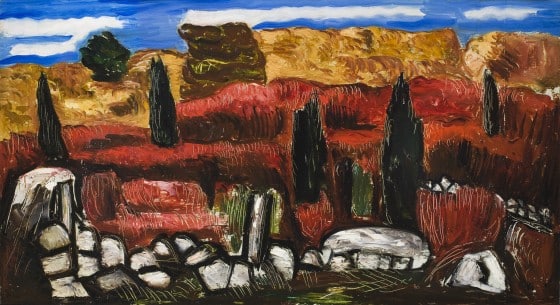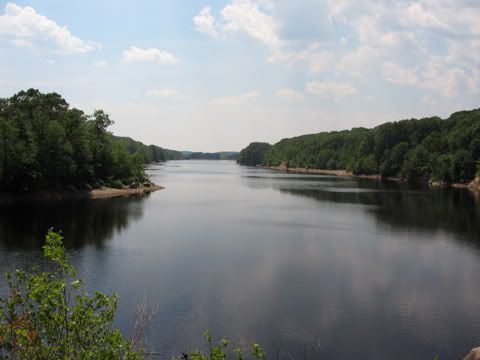Marsden Hartley
Marsden Hartley was born in Lewiston, Maine in 1877. He was a talented artist, and during his youth he attended multiple art schools and focused on painting. While he was successful as an artist, Hartley suffered from feelings of abandonment at an early age and the fact that he was homosexual in a time when this was widely unaccepted. For a long period in his life, Marsden avoided visiting New England for painting. His expertise was in painting murals, but the memory of his early life in New England brought him painful, emotional memories.
Fortunately, he finally gave in after being convinced to paint the region he was born in. Hartley traveled to Gloucester, and at the time he was very sick. After a few weeks, however, he began painting. At some point, Hartley decided to take a walk into the Dogtown woods and paint what he saw. He fell in love with the place. Hartley would sit in the woods for hours, absorbing the beauty and peace within them, before heading home to paint what he had observed.
While sitting alone in Dogtown, Hartley seemed to connect with the woods. Perhaps it is because he felt a sense of similarity with the woods. Just like the woods had been abandoned, Hartley felt abandoned too. His entire life he had felt rejected, despite his success. Dogtown itself was a place of rejection. Within this sense of connection within Dogtown, Hartley produced what are considered to be some of his best paintings, the same paintings that inspired Elyssa East to write her book about Dogtown. Hartley was an outsider who perfectly experienced the simultaneous isolation and connection in Dogtown that can be obtained, and he used the power of the woods and himself to create some of the art that has made him such a prominent artist in today's world.
Elyssa East
In Elyssa East's book, Dogtown: Death and Enchantment in a New England Ghost Town, she combines her experiences in Dogtown
with her research about the place and the events to create a detailed, enthralling piece of work. Inspired by the paintings by Marsden Hartley, East travels to Gloucester with the hopes of understanding the magic which encompassed Mr. Hartley in the woods. At first, the spark did not exist. East writes about her first experience in Dogtown. It grew dark while she was lost among the paths, and fear almost took her over in the night. She continued her research, though, and found a quote from Hartley that stated that when he came across a place he desired to paint, he "did as I always have to do about a place—look at it—see it—and think of nothing else.” After reading this quote, Elyssa East decided to try and do as Hartley had by observing the woods and thinking of nothing else.
When East did so, she admits that she was unsure whether or not she would continue to look for inspiration in Dogtown. For the last line of her book, before the epilogue begins, she writes, "As for me, I was not so sure I would continue seeking inspiration from Dogtown, but knowing that this forgotten corner of America continued to exist and understanding some of its strange past filled me with a sense of auspice and wonder. Dogtown was now mine, just as it had belonged to Hartley and many others." This statement alone does an amazing job of encompassing what I find to be the purpose of Dogtown in one simple phrase. Dogtown is not a place that should be owned and controlled by one particular person. It is a beautiful woodland filled with nature, history, legend, and mystery.
It is a place that should belong to everybody who wishes to respect it and appreciate what the place has to offer. Dogtown is somewhere to find connectedness within isolation, and this opportunity should be open to everybody without the fears of witches, beasts, or murder.
Peter Anastas
Peter Anastas, the former chair of the Dogtown Advisory Committee, is a Gloucester man who has deep roots invested within Dogtown and the opportunities they offer. After sending him an email asking him to share some of his feelings about the place, Mr. Anastas discussed his work in fighting for the preservation of these woods as a place that is a "nature preserve and a place for passive
recreation--hiking, walking, gathering berries, studying the cellar holes, the natural and geological history and the flora and fauna, and biking with bicycles that do not damage the terrain."
While many people seem to avoid visiting Dogtown because of a deep fear and misunderstanding about the place, many others like Anastas treasure it. In a Foreword to Marc Carlotto's guide to Dogtown, Anastas makes a wonderful point about the importance of Dogtown to people in Gloucester: As our lives become increasingly hectic with less and less time for contemplation or solitude, places like this buried in nature give us a chance to escape the burdens of our lives at home and simply marvel in the nature
surrounding us in peace.
An important thing to note is that, like any other woodland area that is not closely monitored, there are dangers. Anastas recognizes that for some Dogtown has become a place for homeless people to hide and cause trouble, as well as a place for partying and trashing. This furthers the argument, however, that we must preserve Dogtown for everything it has to offer.
The information above was gathered from:
East, Elyssa. Dogtown: Death and Enchantment in a New England Ghost Town. New York:
Free, 2009. Print.
"Marsden Hartley - Bio." American Art at the Phillips Collection. The National Endowment for
the Arts, n.d. Web. 10 June 2015.
<http://www.phillipscollection.org/research/american_art/bios/hartley-bio.htm>.Smee, Sebastian. "Marsden Hartley Turns Dejection into Great Art in 'Dogtown' Show at Cape
Ann Museum." Boston.com. The New York Times, 18 June 2012. Web. 28 May 2015.
<http://www.boston.com/ae/theater-arts/2012/06/19/marsden-hartley-turns-dejection-into
-great-art-dogtown-show-cape-ann-museum/5mGQcHBO0pk9I3X3I2amsI/story.html>.






No comments:
Post a Comment